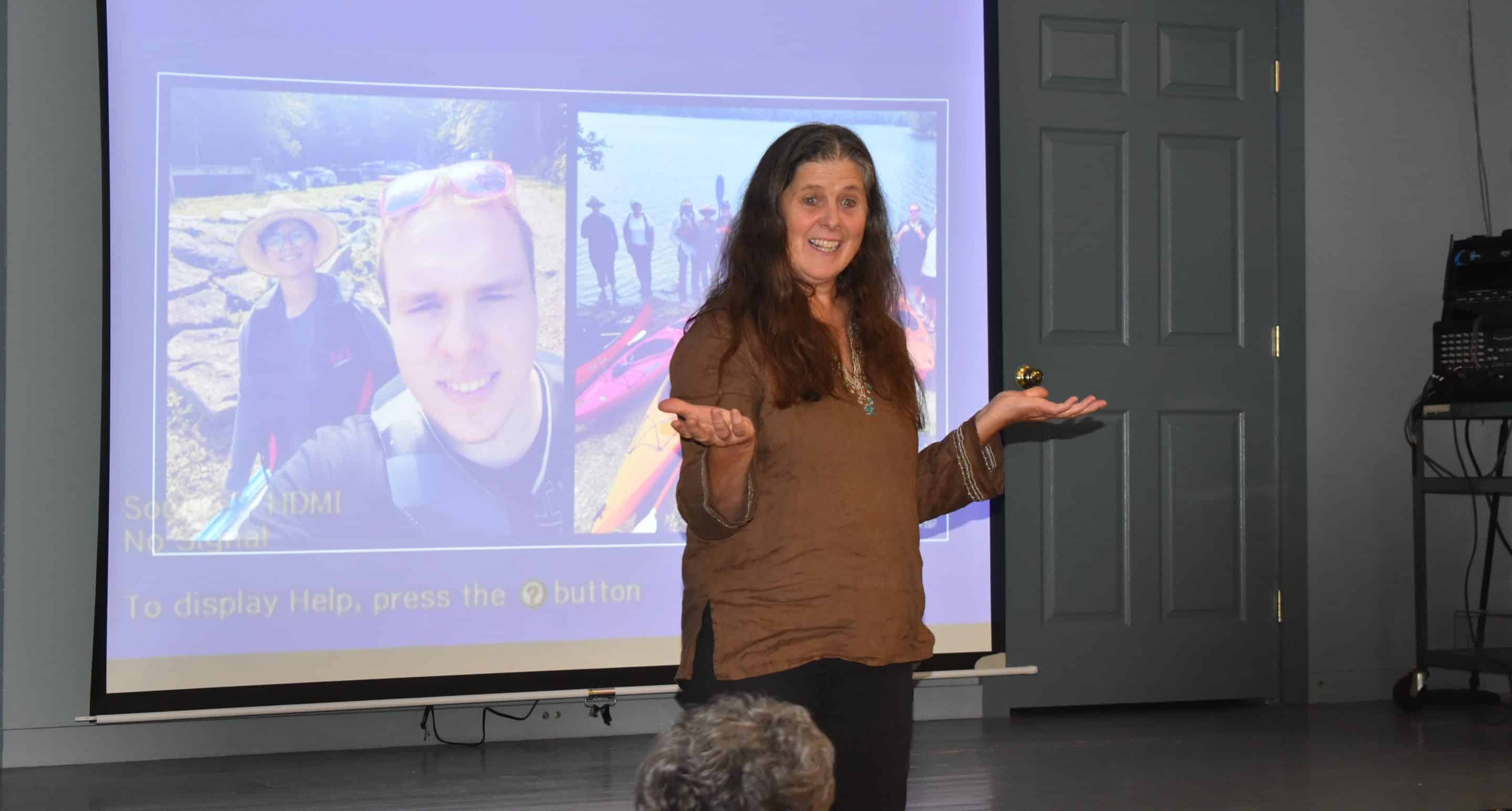Meredyth Babcock, volunteer and projects coordinator for the Wild & Scenic Westfield River Committee, speaks at the organization’s annual potluck on Oct. 24.
Reminder Publishing photo by Amy Porter
HUNTINGTON — The Wild & Scenic Westfield River Committee, volunteers and river enthusiasts recently met for an end-of-season potluck at Stanton Hall to celebrate the year’s activities, and to hear from student interns about their work on invasive plants.
“Every year we gather,” said Meredyth Babcock, volunteer and projects coordinator for the committee. “The interns have done a tremendous amount of work this summer walking a headwater stream and gathering data to find where the invasives are.” She added that wherever the interns worked along the river, they sent letters in advance to abutting landowners and invited them to join them. “It’s exciting for us, they have a lot of information.”
Babcock also pointed out new “pullerbear” equipment that the committee had bought for area towns along the rivers. The pullerbear is a tool that makes it easier for individuals to remove plants all the way down to the root. She said one will be donated to each town, and will be available for residents to borrow and use on their own properties.
Izaak Vigil-Sagan, a second-year intern from the University of Massachusetts, said the 78 miles of the Westfield River was designated in 1993 as a federal Wild & Scenic River. Beginning in May, the group did a qualitative assessment of invasives along Depot Brook. Starting with its headwaters in the town of Washington, Depot Brook runs for 4.5 miles before its confluence with the West Branch of the Westfield River. The group studied 2.5 miles of the brook.
Vigil-Sagan said the main source of the brook is in a swamp abundant with native azaleas, bunchberry and blue cohosh, all indications of sweet nutrient-rich soil in the area, which borders October Mountain State Forest. He said no invasives were found at the headwaters.
In early June, below Beach Road, the stream widened out, and there was an established community of brook trout, which he said indicated a passage into the headwaters, and a beaver pond. A few invasives were spotted, but they were sparse.
The further down the group traveled over the next two months, the more signs of development were seen, and more invasives. At the first, where they saw signs of historical logging and an even-aged young hemlock forest, there were coltsfoot and some Japanese knotweed, the latter of which became the most problematic infestation along the brook.
He said native plants were still flourishing despite the invasives, and he was happy to find one berry on a native honeysuckle in the midst of invasive honeysuckles. “Despite ending with massive invasives, it was heartening to see few invasives at the headwaters. Invasive removal has to be top down, and start at headwaters,” Vigil-Sagan said.
Natalia Ruiz, also a second year intern from UMass, said the group did a study of the Japanese knotweed that had become the main target of their field work and data collection over three years. She said knotweed is indigenous to East Asia, and was brought over in the 1880s as an ornamental privacy plant.
“Knotweed is one of the most widely spread in the world, and is on every continent except Antarctica,” Ruiz said. She said in Asia, the plant is widely used as medicine, and is also edible both raw and cooked. She said what makes knotweed so invasive is its ability to spread from its rhizomes — modified stems that travel underground. She said a small piece can flow downriver and establish a new fast-growing colony.
“What makes it so destructive is that it’s tall, dense and wide, and prevents the growth of other species,” Ruiz said.
She said knotweed also doesn’t stabilize river banks, but breaks up the soil; is incredibly efficient in storing nutrients; and can lay dormant for years. She said most highway departments mow dense growths to the ground, which is the most cost- and time-effective way to deal with them, but also spreads rhizomes.
The Wild & Scenic group identified a project plot and applied the “Karro Frost method” of cutting the top of each knotweed plant in the plot by two or three nodes, then stripping all of the leaves from each main stalk, leaving two at the top. They repeated the method every two weeks during the growing season, which weakens the plant as new growth emerges without mowing it. Ruiz said they found a 65% reduction of new growth in the shady spot of the patch, and 50% in the sunny spot, using this method. After three years, other plants were growing in the patch.
“As you continue to do this, if persistent, over time it decreases knotweed,” Ruiz said, adding that for smaller patches with dedicated landowners, there is hope for fighting invasives.
Babcock said the group received permission from the town of Washington to work on the roadside site.
“I get really sad at the end of the season,” Babcock said, thanking the interns for their work, for which the Wild & Scenic River Committee gets funding from the National Park Service.
Babcock said the committee started its year at Chester on Track with an informational booth. Other projects the committee and its volunteers are undertaking include reaching out to highway superintendents to consider using brine instead of salt on winter roads. They also help departments to clean up culverts. Another initiative is helping landowners remove barberry, which harbors ticks, and is one of the uses of the pullerbear equipment.
“I’ve had the pleasure of working with all of the elementary schools,” she said, and talked about a project done behind Chester Elementary School at its river access, accompanied by intern Izaak Vigil-Sagan. She said the Wild & Scenic Committee has funded with a grant a little trail to get to the river behind the school more easily.
“Walking the river roads is an incredible way of seeing the river as a whole,” Babcock said, showing a photo of the group discovering a bear print along the way. “If our footprints could only leave as little degradation as theirs do.”
At the end of the meeting, Harry Rock, race director for the upcoming 70th annual Wildwater Races on April 19, 2025, thanked the Wild & Scenic Committee for its support of the races, through grants for portable toilets. He said donations and volunteers will be needed this year. An initial planning meeting is scheduled for Nov. 14 at 6 p.m., also at Stanton Hall in Huntington.
A representative from the National Park Service also stood up and thanked the Wild & Scenic Westfield River Committee for its work in preserving the river.



